#ai bs
Explore tagged Tumblr posts
Text
Oh dear.
So as some of you may know, I love to point and laugh at bad legal arguments. And as fun as legal dumpster fires are when they are made by people who aren’t lawyers but think this whole “law” thing seems pretty simple, it’s even funnier when an actual, barred attorney is the person dumping gallons of kerosene into the dumpster.
And oh boy folks, do I have a fun ride for y’all today. Come with me on this journey, as we watch a lawyer climb into the dumpster and deliberately pour kerosene all over himself, while a judge holds a match over his head.
The court listener link is here, for those who want to grab a few bowls of popcorn and read along.
For those of you who don’t enjoy reading legal briefs for cases you aren’t involved with on your day off (I can’t relate), I will go through the highlights here. I will screenshot and/or paraphrase the relevant portion of the briefs, and include a brief explainer of what’s going on (and why it’s very bad, but also extremely funny). (Also, I’m not going to repeat this throughout the whole write-up, so for the record: any statements I make about how the law or legal system works is referring exclusively to the U.S. (And since this is a federal case, we are even more specifically looking at U.S. federal law.) Also, I don’t know how you could construe any of this to be legal advice, but just in case: none of this is, is intended to be, or should be taken as, legal advice.)
First, let’s get just a quick background on the case, to help us follow along. In brief, this is a civil tort suit for personal injury based on defendant’s (alleged) negligence. The plaintiff is suing the defendant (an airline), because he says that he was injured when a flight attendant struck his knee with a metal cart, and the airline was negligent in letting this happen. The airline filed a motion to dismiss on the grounds that there is an international treaty that imposes a time bar for when these kind of cases can be brought against an airline, and the plaintiff filed this case too many years after the incident.
The fun begins when the plaintiff’s attorney filed an opposition to the motion to dismiss. (So far, a good and normal thing to do.) The opposition argues that the claim is not time-barred because 1) the time bar was tolled by the defendant’s bankruptcy proceedings (that is, the timer for the time limitation was paused when the defendant was in bankruptcy, and started again afterwords), and 2) the treaty’s time limit doesn’t apply to this case because the case was filed in state court before the state statute of limitations expired, and the state court has concurrent jurisdiction over this kind of case.
I’m struggling a bit to succinctly explain the second reason, and there’s a reason for that.
You see, the whole opposition reads a bit…oddly.
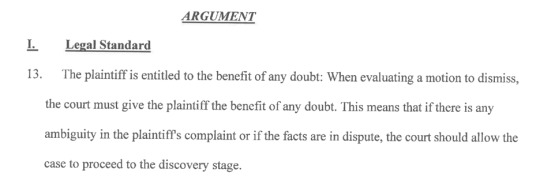
This is how the opposition begins its argument, and it’s…weird. The basic principle is...mostly correct here, but the actual standard is that when reviewing a motion to dismiss for failure to state a claim (which is what the defendant filed) the court must draw all reasonable factual inferences in the plaintiff’s favor. But even then, you don’t just put that standard in your opposition. You cite to a case that lays out the standard.
Because that’s how courts and the law work. The courts don’t operate just based on vibes. They follow statutory law (laws made by legislature) and case law (the decisions made by courts interpreting what those laws mean). You don't just submit a filing saying, "here's what the law is," without citing some authority to demonstrate that the law is what you say (or are arguing) it is.
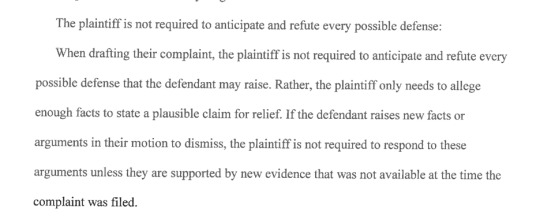
Again, this isn’t wrong (although I'm not sure what it means by new arguments?), but it’s weird! And part of the reason it’s weird is that it is irrelevant to the defendant’s motion to dismiss. The defendant filed a motion stating that based on the facts in the complaint, the plaintiff has not stated a claim based on which relief can be granted, because the complaint is time barred by a treaty. There is no reason for this language to be in the opposition. It’s almost like they just asked a chatbot what the legal standards are for a motion to dismiss for a failure to state a claim, and just copied the answer into their brief without bother to double-check it.
The opposition then cites a bunch of cases which it claims support its position. We will skip them for now, as the defendant will respond to those citations in its reply brief.
The last thing in the brief is the signature of the lawyer who submitted the brief affirming that everything in the brief is true and correct. An extremely normal - required, even! - thing to do. This will surely not cause any problems for him later.

The next relevant filing is the defendant’s reply brief. Again, the existence of a reply brief in response to an opposition is extremely normal. The contents of this brief are…less so.

Beg pardon?
Just to be clear, this is not normal. It is normal to argue that the plaintiff’s cases are not relevant, or they aren’t applicable to this case, or you disagree with the interpretations, or whatever. It is not normal for the cases to appear to not exist.
Some highlights from the brief:
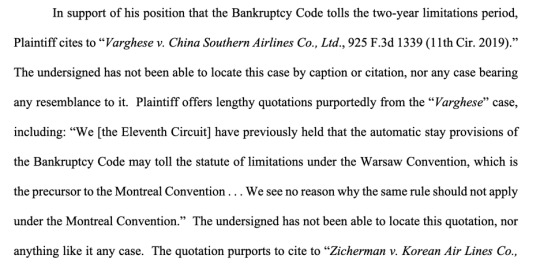

Quick lesson in how to read U.S. case citations! The italicized (or underlined) part at the beginning is the name of the case. If it is a trial court case, the plaintiff is listed first and the defendant second; if the case has been appealed, the person who lost at the lower court level (the petitioner/appellant) will be listed first, and the person who won at the lower level (the respondent/appellee) will be listed second. There are extremely specific rules about which words in these names are abbreviated, and how they are abbreviated. Next, you list the volume number and name of the reporter (the place where the case is published), again abbreviated according to very specific rules, then the page number that the case starts on. If you are citing a case for a specific quote or proposition, you then put a comma after the beginning page number, and list the page number(s) on which the quote or language you are relying on is located (this is called a “pincite”). Finally, you put in parenthesis the name of the court (if needed)(and again, abbreviated according to extremely specific rules) and the year the case was decided.
So the plaintiff’s response cited to Zicherman, which they said was a case from 2008 that was decided by the 11th Circuit Court of Appeals. However, the defendant was not able to find such a case. They were able to find a case with the same name (the same petitioner and respondent), but that case was decided by the U.S. Supreme Court in 1996, and the lower court cases associated with that case weren’t in the 11th circuit either. (The United States Reports is the only official reporter for the U.S. Supreme Court, and only includes SCOTUS decisions, so it’s not necessary to include the name of the court before the year it was decided.)
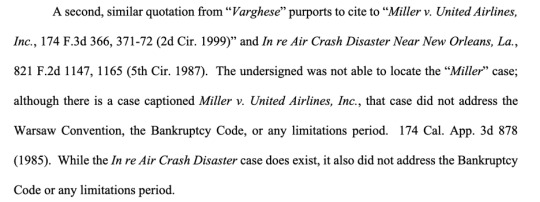
Just to be clear. The defendant’s brief is saying: the plaintiff cited and extensively quoted from these cases, and neither the cases nor the quotations appear to exist. These “cases” were not ancillary citations in the plaintiff’s brief. They were the authority it relied upon to make its arguments.
This is as close a lawyer can come, at this point in the proceedings, to saying, “opposing counsel made up a bunch of fake cases to lie to the court and pretend the law is something different than it is.”


That, “Putting aside that here is no page 598 in Kaiser Steel,” is delightfully petty lawyer speak for, “you are wrong on every possible thing there is to be wrong about.”
By page 5, the defendant has resorted to just listing all of the (apparently) made up cases in a footnote:


(skipping the citations to support this proposition)

This is where I return to my struggle to explain the opposition’s second reason why the motion to dismiss should not be granted. I struggled to explain the argument, because they failed to explain why the argument they were making (that plaintiffs can bring lawsuits against airlines in state court, and the state court have specific statutes of limitations for general negligence claims) was relevant to the question of whether the plaintiff’s specific claim against the airline was time barred by the treaty. Because 1) this case is in federal court, not state court, and 2) federal law - including treaties - preempts state law. Again, it’s almost like plaintiff’s attorney just typed a question about the time bar into a chatbot or something, and the machine, which wasn’t able to reason or actually analyze the issues, saw a question about the time to bring a lawsuit and just wrote up an answer about the statute of limitations.
We also end with a nice little lawyerly version of “you fucked up and we are going to destroy you.” The relief requested in the defendant’s original motion to dismiss was:

In their reply to the opposition, however:

“The circumstances” in this case, being the apparent fabrication of entire cases. Because courts tend to take that pretty seriously.
And the court took it seriously indeed. The defendant’s reply was docketed on March 15th of this year. On April 11th:

AKA: you have one week (an extremely prompt time frame for federal court) to prove to me that you didn’t just make up these cases.
On April 12th, the plaintiff’s attorney requests more time because he’s on vacation:

The judge grants the motion, but adds in another case that he forgot to include in his first order.
On April 25th, the plaintiff’s attorney files the following:

(And he lists the cases, with one exception, which he says is an unpublished decision.)
But he says of all of the cases except two, that the opinions…

Which is…nonsense?
First of all: if you cited a case, you had to get it from somewhere. Even unpublished opinions, if you are citing them in a brief, you are citing them because you pulled them off of westlaw or whatever. Which means you have access to the case and can annex it for the court. (There are even formal rules for how you cite unpublished opinions! And those rules include citing to where you pulled the damn case from!)
Secondly: remember that long digression I went into about how to read case citations? Remember that bit about how you include the name of the reporter (the place the case was published)? Yes, cases are published. They are printed in physical books, and they are published online in databases (e.g. lexis or westlaw). If the specific online database you are looking in does not have the case, you look somewhere else. If you have a judge telling you to get them a copy of the case Or Else, you track down a physical copy of the reporter if you need to and scan the damn thing yourself. You - literally - can’t just not have a copy of the case! (Especially published federal circuit court opinions, which multiple of these cases are! Those aren’t hard to find!)
And what kind of “online database” doesn’t include the entire opinion anyway? I’ve literally never heard of a case research database that only included partial opinions, because that wouldn’t be useful.
Maybe if we look at the attached annexed copies of the cases, that might give us some answers.
...
My friends, these things are just bizarre. With two exceptions, they aren’t submitted in any sort of conventional format. Even if you’ve never seen a legal opinion before, I think you can see the difference if you just glance through the filings. They are located at Docket entry #29 on Court Listener (April 25, 2023). Compare Attachments 6 and 8 (the real cases submitted in conventional format) to the other cases. Turning to the contents of the cases:
In the first one, the factual background is that a passenger sued an airline, then the airline filed a motion to dismiss (on grounds unrelated to the treaty's time bar), then the airline went into bankruptcy, then the airline won the motion to dismiss, then the passenger appealed. And the court is now considering that appeal. But then the opinion starts talking about how the passenger was in arbitration, and it seems to be treating the passenger like he is the one who filed for bankruptcy? It’s hallucinatory, even before you get to the legal arguments. The “Court of Appeals” is making a ruling overruling the district court’s dismissal based on the time bar, but according to the factual background, the case wasn’t dismissed based on the time bar, but on entirely other grounds? Was there some other proceeding where the claim was dismissed as time barred, and it’s just not mentioned in the factual background? How? Why? What is happening? Also it says Congress enacted the treaty? But, no? That’s…that’s not how treaties work? I mean, Congress did ratify the treaty? But they didn’t unilaterally make it!
In the second case, there’s an extended discussion of which treaty applies to the appellants claims, which is bizarre because there are two relevant treaties, and one replaced the other before the conduct at issue, so only the new treaty applies? There isn’t any discussion of the issue beyond that basic principle, so there is no reason there should be multiple paragraphs in the opinion explaining it over and over? Also, it keeps referring to the appellant as the plaintiff, for some reason? And it includes this absolutely hallucinatory sentence:

…the only part this that makes sense is that the argument is without merit. I’m not going to discuss the actual merits of the legal arguments in the opinion, because they are so bizarre and disjointed that even trying to describe them would require a Pepe Silvia-sized conspiracy board. Like the previous case, both the facts and the legal posture of the case change constantly, with seemingly no rhyme or reason.
The third one…oh boy. First, large portions of the “opinion” are individual paragraphs with quotations around the whole paragraph. What’s happening there? As far as the content of the opinion itself - I can’t. I mean that, I literally can’t. What is being discussed seems to change from paragraph to paragraph, much of it contradicting. It makes the first case seem linear and rational by comparison. The court finds it doesn’t have personal jurisdiction over the defendant so dismisses the case based on a lack of subject matter jurisdiction? But also the defendant hasn’t contested jurisdiction? And also the court does hold that it has both subject matter and personal jurisdiction over the defendant? And then it denies the motion to dismiss the case? Also, at one point it cites itself?
…also, even if this was a real case, it doesn’t stand for the propositions the plaintiff cited it for in their opposition? I’m not going to go into the weeds (honestly it’s so hallucinatory I’m not sure I could if I tried), but, for example, the plaintiff’s reply brief states that the court held “that the plaintiff was not required to bring their claim in federal court.” The U.S. District Court for the District of Columbia is a federal court, and there is no discussion of any filings in state courts. The closest the “opinion” comes is with the statement, “Therefore, Petersen’s argument that the state courts of Washington have concurrent jurisdiction is unavailing.” (This statement appears to be completely disconnected from anything before or after it, so I am unsure what it is supposed to mean.)
Moving on, case number four is allegedly a decision by the Court of Appeals of Texas. It includes the following line:

Honestly, the plaintiff’s attorney best defense at this point is that he wasn’t intentionally trying to mislead the court, because if he was doing this on purpose, he would have edited the cases to make them slightly more believable. (Context in case you’ve lost track: these documents are supposed to be copies of the opinions he is citing. The screenshoted line makes it clear that what he is actually citing is, at best, someone else’s summary of an "opinion". It would be like if a teacher asked a student to photocopy a chapter of a book and bring it into class, and instead the student brought in a copy of the cliffs notes summary of that chapter. Except that the book doesn’t even exist.)
The actual contents of the “opinion” are, as is now standard, absolutely bonkers. First, the court decides that it doesn’t have personal jurisdiction over Delta because “Delta did not purposefully avail itself of the benefits of conducting business in Texas.” This was despite the fact that the factual background already included that the appellant (sorry, the plaintiff, according to the “opinion”) flew on a Delta flight originating in Texas. Like, this is just wrong? It’s not even hallucinatory nonsense, it’s just facially incorrect legal analysis. Then the court starts discussing the treaty’s time bar, for some reason? Then it goes back to talking about personal jurisdiction, but now the trial court denied the defendant’s motion to dismiss for lack of personal jurisdiction, and the appellate court agrees with the trial court that it does have personal jurisdiction, even though this is the plaintiff’s appeal from the dismissal for lack of personal jurisdiction and the court already ruled it didn’t have personal jurisdiction? And even though on page 1, the plaintiff was injured during a flight from Texas to California, now on page 7 she was injured on a flight from Shanghai to Texas? Also the trial court has gone back in time (again) to grant the motion to dismiss that it previously denied?
Also, I’ve been trying to avoid pointing out the wonky text of these submissions, but:

Everything ok there?
Case number five is similar enough to number four that it’s not worth repeating myself.
Thank god, cases six and eight, as noted above, are real cases, so I’m going to skip them. The defendant alleges that the cases do not stand for the propositions the plaintiff cited them for, and I’m going to assume that is true, given the rest of this nonsense.
Case number seven looks legitimate on the surface. But neither the defendant nor I could find the case through any legitimate search mechanisms. The defendant looked up the purported docket numbers on PACER and found completely different cases; I was able to find a case with the name “Miller v. United Airlines, Inc.,” but it was for a different Ms. Miller, it was a California state case (not a Second Circuit federal case), it was decided on a different year, and the substance of the case was entirely different from the alleged opinion filed with the court.
On top of that, this might be the most morally reprehensible fake citation of them all? Because it is about the crash of United Airlines Flight 585, a real plane crash. Everyone on board - 25 people in total - was killed.
The individual cited in this fake court case was not one of them.
I cannot imagine conducting myself in such a way where I would have to explain to a judge that I made up a fake case exploiting a real tragedy because I couldn’t be bothered to do actual legal research.
Now, I know you all have figured out what’s going on by now. And I want you to know that if your instincts are saying, “it seems like the lawyer should have just fallen on his sword and confessed that he relied on ChatGPT to write his original brief, rather than digging himself further into this hole”? Your instincts are absolutely correct.
Because obviously, the court was having none of this b.s. On May 4th, the court issued an order, beginning with the following sentence:

That is one of the worst possible opening sentences you can see in an order by the court in a situation like this. The only thing worse is when judges start quoting classic literature. If I was Mr. Peter LoDuca, counsel for the plaintiff, I would already be shitting my pants.
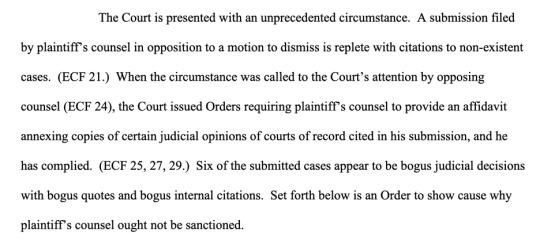
“I gave you an opportunity to either clear things up or come clean. Now I’m going to give you an opportunity to show why I should only come down on you like a pile of brinks, instead of a whole building.”

We are getting dangerously close to “quoting classic lit” territory here.

If I learned that the judge in my case called up the clerk of a circuit court just to confirm how full of shit I was, I would leave the legal profession forever. Also, the judge is now also putting quotes around “opinion.” When judges start getting openly sarcastic in their briefs, that means very very bad things are about to happen to someone.

So I’m guessing the delay between this filing and the court order was because the judge’s clerk was tasked with running down every single one of the additional fake citations included in the "opinions", just to make this sure this order (and the upcoming pile of bricks) are as thorough as possible.

If you are following along with Dracula Daily, the vibe here is roughly the same as the May 19th entry where Dracula demands Jonathan Harker write and pre-date letters stating he has left the castle and is on the way home.
Also, hey, what’s that footnote?

Wait, what?
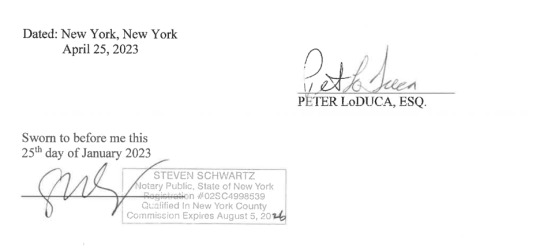
Folks, it appears we may have notary fraud, on top of everything else! Anybody have bingo?
So on May 25, one day before the deadline, Mr. LoDuca filed his response. And oh boy, I hope ya’ll are ready for this.
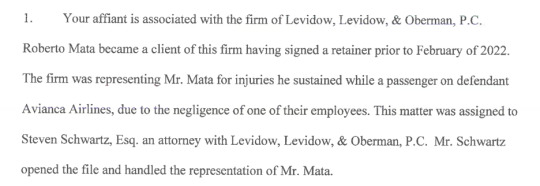
Hey, what’s the name of that other attorney, “Steven Schwartz”? Where have I seen that name before…
...I ran out of room for images on this post. So I'm going to have to leave this as an accidental cliffhanger. Part 2 to follow once I refresh my tea.
9K notes
·
View notes
Text
people using ai tools for their writing think nobody can tell the difference and that's such a powerful self own

#ai bs#ah yes this is exactly how people write#this post is definitely a funny resource for users at any stage#the life of maxi
59 notes
·
View notes
Text
man, the more "ai art" discourse i read, the more convinced i am that the people defending ai art don't understand the point of making art is making art.
they just want to look at pictures.
20 notes
·
View notes
Text


there’s probably posts on here and twitter that can describe this better but corporations doing shit like this because they rather not give better pay, and terms and conditions to their artists, animators, writers, and crew overall is frankly embarrassing and disgusting

#ai bs#wga strike#they prefer art be made by a computer than human artists that give imagination and soul#fucking hell#bailey rambles#ant ai
169 notes
·
View notes
Text
Turn off AI on LinkedIn
By default, anyone with a LinkedIn account has "opted in" for AI training on your content. You can turn it off here:
If the link doesn't load: Go to LinkedIn, choose Settings > Data Privacy > Data for Generative AI Improvement. Make sure the slider is set to "Off".

A default setting doesn't strike me as an "opt in", but I'm not an in-house corporate attorney making a high six figure salary to craft weasel-worded policies.
15 notes
·
View notes
Text
Also in regards to the Ai post I reblogged earlier regarding wotc. I know people have said it’s for their game dev operation but also seeing these art peices in spoilers today (mostly the tokens) really solidified how fucked we are.
The Fox token is the worst by far imo showing the tufting that generative ai does with fur and having weird fucked up paws when kamigawa Kitsune usually have hands. Also its snout seems kinda fucked up
The moon folk token kinda just has some hank anatomy with the shoulders and the lines on the whole pic just feel wrong.
Not sure about Genius himself but the hands are weird and I see tufting on Nashi and the fox again along with them being different than their respective tokens by a long shot.
This guy did 4 slots in the set and looking through his other pieces from before this most look fine, but different stylistically from these three. I’m gonna try to see if he posts process pics but the fact I can’t trust the art I’m seeing on cards makes me genuinely want to stop engaging with the game which has been a big part of my life for the past like decade.



9 notes
·
View notes
Text
To indie authors, musicians, etc., needing art for their projects:
Please consider doing what those before you did and take some time to learn some basic graphic design skills with free tutorials using free programs with free stock photos and free fonts. You do not need AI.
If you can save up even a bit of funding, a LOT of artists also happily work with limited budgets, or have contacts they know that might work better for your budget. All you have to do is ASK. Some artists take payment plans as well. Most of us are very flexible!
I know y'all hate the idea of people using your work and producing AI crap in your industry, understand that us artists feel the same way! Our jobs are being stolen, our work torn from our hands. Please don't contribute to that. There are so many other options, I promise.
9 notes
·
View notes
Text
You know... it used to annoy me, too, when people would find the bit in a website's TOS granting them basically free rein to display and store your content blah blah blah, and freak out about it. Because yeah, that's apparently the standard language they all use to mean "you're giving us the right to display what you post".
But now, with all the A.I. shit going on, the mass scraping of visual art and writing to train models for A.I. applications without permission, credit, or compensation? The way it's justified as “well, if you post stuff online, it's fair game” and “you gave up your right to control your work when you posted it publicly”? Absolutely fuck that being the “standard” language.
I don't care what you, personally, think of the legality of it. We demonstrably have created a culture in which artwork is treated as free fodder for anyone else to exploit and profit from. And anything that continues to encourage this idea of “blanket permission to do whatever we want with your posted work” needs changed. Websites can be fucking specific about what exactly I'm giving them the right to do, instead of couching it in vague legal jargon that can be creatively re-interpreted later. And we should demand that of them.
7 notes
·
View notes
Text
Followed by their sibling: What the fuck are those subtitles! That's not what they saiiid!
Every time i start a new vido game:
OH FUCK WHERE ARE THE SUBTITLES
206K notes
·
View notes
Text
Ok. I am maybe kind of losing my mind just a little bit.
A few days ago, I mentioned in a post that the IA only cares about information being digitized, not about actual digital access. And I mentioned that access includes patrons being able to actually find what they are looking for, and suggested IA did not prioritize that critical aspect of access. But I didn't really go into any more detail.
So someone over on bluesky linked to this write-up of a talk Brewster Kahle gave about using so-called AI. And one of his reported statements made my mouth drop open in shock.
...and then I read further in the article and realized it was incorrectly reporting basic facts around Hachette, so I had to go and listen to the whole speech myself.* (And I want to say, briefly - he raises some legitimate potential uses for LLMs! He's kind of a dick about some of it ("it's up to us to go and keep [Balinese] culture alive"), but some of the things he's talking about actually seem useful.)
*Incidentally, while Kahle doesn't lie about the ALA brief in the speech, he absolutely misleads about the nature and facts of the case and deliberately omit the part of the story where the IA decided to suspend the one-to-one owned-to-loan ratio thing, despite repeatedly emphasizing that one-to-one was what the IA was doing with their lending program.
And oh my god. He really said what the article reports. (This portion starts around 20:10.)
He says that the IA has scanned over 18,000 periodicals. And that they used to have professional librarians manually create descriptions of the periodicals in order to catalog them. (Sidenote: there are existing directories, but he describes their licensing terms as "ridiculous." This is not a field I know much about, but I spoke to one person who agreed, though for different reasons. His reason is that you can only license, not purchase, the directory descriptions. The person I spoke to was instead focused on the prices demanded for the licenses. Regardless, the idea of creating an open, free directory seems both like an incredible amount of work and an amazing resource...if it was accurate.)
But according to Kahle, it took 45 minutes to an hour to create a description and catalog each periodical.
And so now, instead, they're using AI to make the descriptions and so it only takes 7-10 minutes!
"And yes it hallucinates, and it has some problems, and whatever — but it’s a lot faster than having to write it yourself!"
Oh. My god.
Just.
YOU ARE KNOWINGLY INTRODUCING AI HALLUCINATIONS INTO YOUR CATALOG?!
(And yes, he says that they are "confirmed by a librarian" but it can't really be, not if it's only taking 7-10 minutes! Maybe the librarian can do a quick check for super obvious errors, but actually checking a AI's summary work requires actually going back to the source and reviewing it yourself!)
I just....
I need to emphasize for those of you for who aren't familiar - if a book or article is miscataloged, it is effectively lost. Because it doesn't mater if a library or an archive owes it - if someone can't find it when they are looking for it, it is not only inaccessible, the only way to find it again is through chance. Imagine if you went into a library, but instead of organized shelves (where if even if you can't find what you're looking for, the librarians know where to look), every single book was just piled in a heap.
If a book is miscateloged, it still exists, but it is lost, not truly accessible. And they know that this is happening, "but whatever." Because Brewster Kahle doesn't actually care about real, practical, digital access. (Much less non-digital access.)
(And then to top it off, he goes on to criticize the Library of Congress for not being "access oriented.")
I just. 18,000 periodicals. And they've knowing, recklessly lost who knows how many of them. I feel like crying.
18,000 periodicals.
#internet archive#ai bs#nope sure don't like using those two tags in the same post#also just admit that you are an archive kahle#archives are great!#I love archives!#they serve a critical purpose distinct from libraries#I don't understand why you seem to hate the idea of being one!#(except I do - the same reason why you won't just admit what the ia did w/ the 'emergency library')
597 notes
·
View notes
Text
Hey wow, I don't have a lot of time to go in depth but Pillowfort's AI policy seems really nice, I wonder if this is anything.
I'll probably be moving my stuff over there after tax season is over, and for now, I'll start cross posting. Something tells me the trust threshold in Tumblr is reaching a tipping point.
27 notes
·
View notes
Text






glad I’m not the only who is pissed off by this bullshit, what the fuck was the point of the sag-aftra strike then if you’re gonna disregard voice actors??!!
Sag-aftra is such a fucking joke rn Jesus Christ
#important#voice acting#fuck ai everything#bailey rambles#anti ai#ai bs#same with writers and artists/animators
2 notes
·
View notes
Text
and like, yes, we need to upgrade the electric grid, but SO WE CAN GET OFF FOSSIL FUELS not so we can piss away a huge percentage of our electricity on ai bullshit.
ed zitron, a tech beat reporter, wrote an article about a recent paper that came out from goldman-sachs calling AI, in nicer terms, a grift. it is a really interesting article; hearing criticism from people who are not ignorant of the tech and have no reason to mince words is refreshing. it also brings up points and asks the right questions:
if AI is going to be a trillion dollar investment, what trillion dollar problem is it solving?
what does it mean when people say that AI will "get better"? what does that look like and how would it even be achieved? the article makes a point to debunk talking points about how all tech is misunderstood at first by pointing out that the tech it gets compared to the most, the internet and smartphones, were both created over the course of decades with roadmaps and clear goals. AI does not have this.
the american power grid straight up cannot handle the load required to run AI because it has not been meaningfully developed in decades. how are they going to overcome this hurdle (they aren't)?
people who are losing their jobs to this tech aren't being "replaced". they're just getting a taste of how little their managers care about their craft and how little they think of their consumer base. ai is not capable of replacing humans and there's no indication they ever will because...
all of these models use the same training data so now they're all giving the same wrong answers in the same voice. without massive and i mean EXPONENTIALLY MASSIVE troves of data to work with, they are pretty much as a standstill for any innovation they're imagining in their heads
56K notes
·
View notes
Text
you say "A.I. can do x just as well as humans can" but all I hear is "I have no taste"
15 notes
·
View notes
Text
"Reviewers told the report’s authors that AI summaries often missed emphasis, nuance and context; included incorrect information or missed relevant information; and sometimes focused on auxiliary points or introduced irrelevant information. Three of the five reviewers said they guessed that they were reviewing AI content.
The reviewers’ overall feedback was that they felt AI summaries may be counterproductive and create further work because of the need to fact-check and refer to original submissions which communicated the message better and more concisely."
Fascinating (the full report is linked in the article). I've seen this kind of summarization being touted as a potential use of LLMs that's given a lot more credibility than more generative prompts. But a major theme of the assessors was that the LLM summaries missed nuance and context that made them effectively useless as summaries. (ex: “The summary does not highlight [FIRM]’s central point…”)
The report emphasizes that better prompting can produce better results, and that new models are likely to improve the capabilities, but I must admit serious skepticism. To put it bluntly, I've seen enough law students try to summarize court rulings to say with confidence that in order to reliably summarize something, you must understand it. A clever reader who is good at pattern recognition can often put together a good-enough summary without really understanding the case, just by skimming the case and grabbing and repeating the bits that look important. And this will work...a lot of the time. Until it really, really doesn't. And those cases where the skim-and-grab method won't work aren't obvious from the outside. And I just don't see a path forward right now for the LLMs to do anything other than skim-and-grab.
Moreover, something that isn't even mentioned in the test is the absence of possibility of follow up. If a human has summarized a document for me and I don't understand something, I can go to the human and say, "hey, what's up with this?" It may be faster and easier than reading the original doc myself, or they can point me to the place in the doc that lead them to a conclusion, or I can even expand my understanding by seeing an interpretation that isn't intuitive to me. I can't do that with an LLM. And again, I can't really see a path forward no matter how advanced the programing is, because the LLM can't actually think.
#ai bs#though to be fair I don't think this is bs#just misguided#and I think there are other use-cases for LLMs#but#I'm really not sold on this one#if anything I think the report oversold the LLM#compared to the comments by the assessors
554 notes
·
View notes
Text
it's very funny to me how a.i. is objectively making so many internet things (search, customer service, etc.) so much worse, to a degree that, in any other case, you'd have to roll it back. but so many people went so hard for a.i. being this amazing futuristic thing that would make everything better with zero effort, and it's too embarrassing to admit how wrong they were, so they're just gonna... keep doing it. very funny. I cannot find any coherent web sites
12 notes
·
View notes